Santa Claus has become one of the most recognizable folklore figures worldwide, and is one of the most iconic elements of this holiday season. His fur trimmed red outfit and bushy white beard is iconic, but good ol’ St. Nick has not always looked the same.
Santa as we know him today has been refined many times over the years, with the legend of good ol’ Saint Nick dating back all the way to the third century.
Read on to discover the true history of Santa Claus like you’ve never heard before!
A Monk Named Nicholas
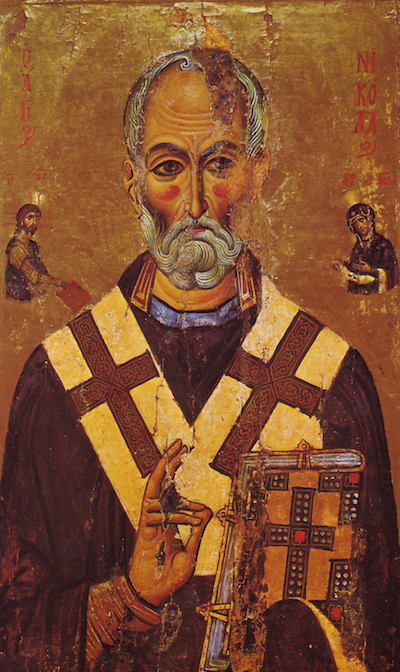
Over 1,700 years ago lived a monk named Nicholas. He was known for his selflessness and generosity and, unsurprisingly, for his gift giving. Nicholas was well known in his homeland of Myra, which is now know as Turkey. Stories of his acts of kindness spread during and after his life, and soon legends of his generosity grew across Europe.
Over time, his legend spread across wider and wider areas, partially due to its popularity with sailors. Back then, the requirements for who became a saint weren’t as clear as they are today. Many religious figures whose stories and reputations lasted over time became canonized as more and more people began to revere them, which is how Nicholas became a saint.
The enduring stories said that he was known for giving away all of his family inheritance to those in need, and traveled the countryside in search of others to help. Legend has it that he was especially well known for tossing gifts through open windows, which would land in or near stockings and shoes left to dry near the fire, which is one suggested explanation for where the tradition of hanging Christmas stockings came from.
St. Nicholas became known as a protector, and to this day the anniversary of his death, December 6th, is celebrated as a day of luck and feast in certain faiths.
St. Nicholas Made His Name in America
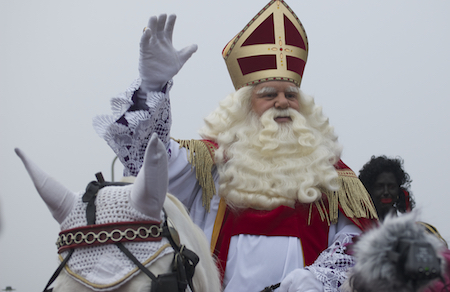
As St. Nicholas’ popularity grew across Europe, he was given nicknames such as the Dutch term Sinterklaas. This was a term of endearment and a form of the words Sint Nikolaas, the Dutch translation of Saint Nicholas.
In the late 1700’s Sinterklaas was featured in a New York newspaper article that reported about Dutch families and their observation of the St. Nicholas day of feast. Over the next century various images of Sinterklaas were created in publications, some showing him with a blue three cornered hat and yellow stockings, others with a broad brimmed hat and a pipe, all with similar depictions of the saint bestowing gifts and food on families.
Washington Irving, the American author who wrote Rip Van Winkle and The Legend of Sleepy Hollow, helped to popularize the legend of St. Nicholas and Sinterklaas when he wrote that St. Nicholas was the patron saint of New York. The name Sinterklaas slowly became Americanized and became Santa Claus over time.
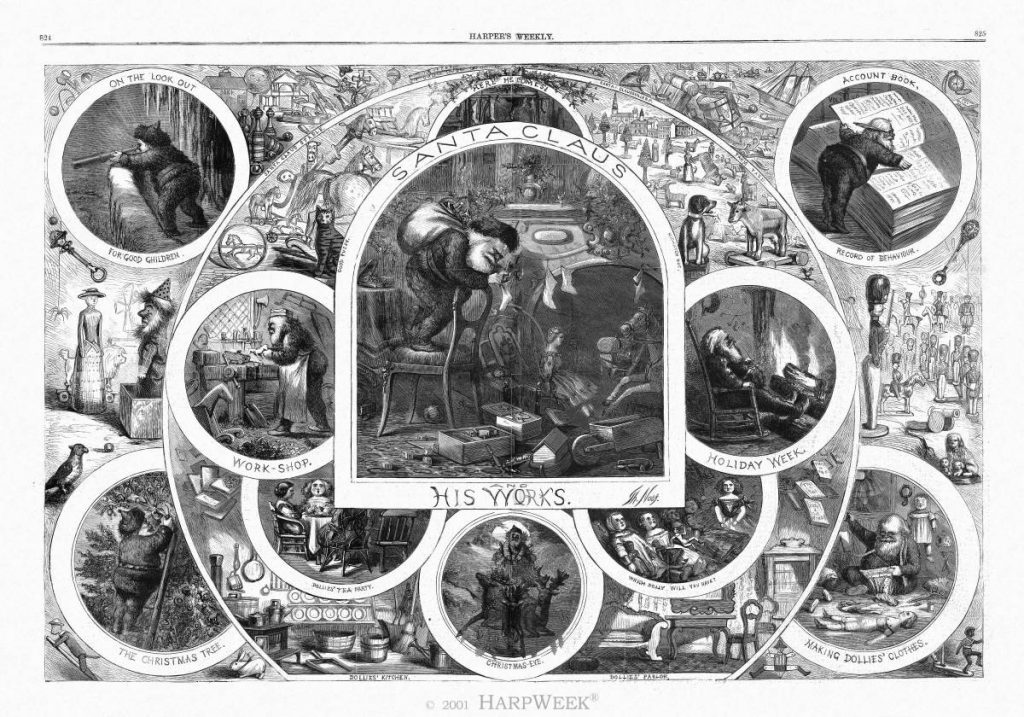
A New Look For Santa
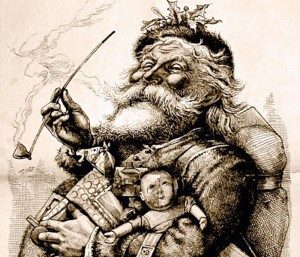
Clement Clarke Moore was a minister who can be held most responsible for creating and popularizing the early image of Santa Claus. In 1822 Moore wrote a Christmas poem for his daughters titled An Account of a Visit From St. Nicholas, which most of us now know as ‘Twas the Night Before Christmas.
In the poem, Moore describes St. Nick as a “jolly old elf” whose belly famously shakes like a bowl full of jelly. The poem was also responsible for the notion that Santa travels from house to house on a flying sleigh led by reindeer and slides down chimneys to deliver gifts.
The poem became so popular amongst the public that it became a household legend and in 1866 cartoonist Thomas Nast illustrated the poem in Harper’s Weekly and brought Santa to life. The illustration below features the portly elf with a white beard who we know so well.
Seeing is Believing
Christmas shopping became truly popular around 1820 with retailers featuring holiday specials and only two decades later newspapers dedicated a whole section to solely holiday shopping advertisements. The newspapers gradually began using the images of Santa Claus to draw people in, and soon Santa was being used everywhere to advertise Christmas specials.
In 1841 a shop in Philadelphia featured a Santa Claus to attract customers, and thousands of children flocked to see the man climbing into and out of a chimney. Soon other retailers followed suit and began offering glimpses of live santas in their stores to draw in children and parents. This became so popular that the tradition has carried on over a century later.
 Through the following decades, the styles of Santa’s dress changed in various ways, only solidifying into the one we recognize today in the 1920s and 1930s. Contrary to what quite a few people think, the Coca-Cola advertisements were not the first instance of the red-suited Santa. The origin of the red suit is actually in the late 1800s, and was further cemented by Norman Rockwell from the 1910s to the 1920s.
Through the following decades, the styles of Santa’s dress changed in various ways, only solidifying into the one we recognize today in the 1920s and 1930s. Contrary to what quite a few people think, the Coca-Cola advertisements were not the first instance of the red-suited Santa. The origin of the red suit is actually in the late 1800s, and was further cemented by Norman Rockwell from the 1910s to the 1920s.
It was in 1931 when an artist named Haddon Sundblom created the original Coca-Cola Santa Claus, using himself as a model. He painted a new tableau of Santa every year for the next 33 years, firmly sealing our conception of how the jolly old elf should look.
Different Names For Santa
This is the history of the Santa Claus that we in North America are familiar with, but were you aware that in other parts of the world Santa’s name and costume is quite different? In France, children are visited by Pere Noel, Switzerland has the childlike Christkind, Germany has Kris Kringle, and Italians expect a visit from Le Befana, a kind witch who flies down chimneys on her broomstick to deliver gifts.
They may seem different, but the general story of a generous holiday figure who brings gifts and joy remains the same.
Santa Claus is Coming to Town
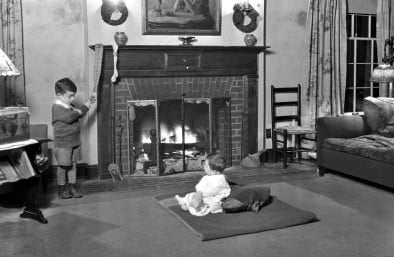 Whether you prefer to think of Santa Claus as an homage to the kind Saint Nicholas, as a magical elf who brings wonder into the hearts of children, or perhaps a little of both ideas, the legend of St. Nick has brought joy into many lives for over a thousand years. He is one of the most prominent holiday figures today, and a constant reminder that kindness and joy are what the holidays are all about.
Whether you prefer to think of Santa Claus as an homage to the kind Saint Nicholas, as a magical elf who brings wonder into the hearts of children, or perhaps a little of both ideas, the legend of St. Nick has brought joy into many lives for over a thousand years. He is one of the most prominent holiday figures today, and a constant reminder that kindness and joy are what the holidays are all about.
Now, to help things remain as festive as possible, here’s a lovely two hour fireplace scene for your enjoyment. And no matter what you celebrate this season, we hope that it’s full of happiness and all of the things that make this time of year special to you!
https://www.youtube.com/watch?v=0fYL_qiDYf0






